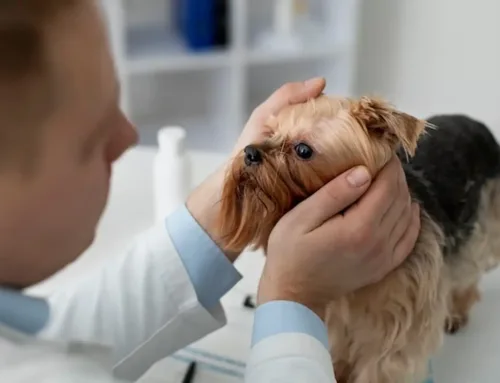Routine veterinary visits help your pet live a long, healthy, and happy life. Early detection and intervention allows our veterinary team to treat a disease in the beginning stages, and then manage the condition with medication or simple lifestyle changes. Your veterinarian can also give you pointers that will help your pet live their healthiest life and stave off potential medical conditions. Our American Animal Hospital Association (AAHA)-accredited team wants to help you prolong your pet’s life by explaining some truths about pet wellness care.
Myth: I would know if my pet were sick.
Truth: Our pets are stoic and instinctually work hard to hide illness. This means that a disease can reach advanced stages before your pet alerts you with any signs. Routine wellness exams and blood work are the best ways to detect conditions in the early stages and improve their prognosis During a routine wellness exam, our doctors perform a thorough evaluation, including:
- Muscles, joints, and bones — Gait changes, limping, and muscle loss are common issues we see in pets. Most older pets suffer from some degree of osteoarthritis, which causes stiffness and muscle loss from pain-related inactivity. Cranial cruciate ligament disease is another common musculoskeletal issue in dogs. This ligament is prone to rupture in overweight or active pets. Similar to an ACL tear in human athletes, this injury can cause serious joint-health problems for your pet if not correctly managed.
- Ears — Ear infections are common in both cats and dogs. Cats often present with ear mites, while dogs routinely display yeast or bacterial infections. Left untreated, ear infections can progress to painful, inflamed, thickened ears, making future cleaning and treatment difficult. We will also look for any masses or polyps that need to be removed.
- Eyes — Eye issues abound in flat-faced breeds, such as bulldogs, pugs, Persians, and several other breeds. Flat-faced pets easily develop corneal ulcers if their protruding eyes are scratched. Other breeds, such as schnauzers, frequently develop cataracts, while cocker spaniels routinely suffer from dry eyes. Glaucoma is another common issue, and if left unchecked, will cause severe eye pain, potential vision loss, and surgical eye removal.
- Mouth — Dental health affects your pet’s entire body and is about much more than just bad breath! We will look for signs of gingivitis, loose teeth, tartar accumulation, and oral masses. Oral bacteria can also travel through the bloodstream to your pet’s heart, kidneys, and other organs, and cause significant damage.
- Skin — Dry, itchy skin and hair loss can indicate a variety of health issues, including mange, allergies, skin infections, endocrine imbalances, fleas, and poor nutrition. Your pet’s overall health can be gauged from the quality of their skin and hair coat.
- Heart and lungs — Older pets are prone to heart disease, but younger cats and dogs also can have problems with heart rhythm and function. Cardiac disease is best managed when signs first appear, and these signs are often only picked up by auscultation with a stethoscope, leading to further diagnostic testing. Many pets hide heart disease, only displaying coughing and exercise intolerance when the disease is advanced. A diseased heart also can affect the lungs, creating difficulty breathing if fluid accumulates around the heart.
- Abdomen — While an abdominal palpation may seem to be a belly massage for your pet, we are checking for abnormal masses and organ size. Enlarged kidneys can indicate renal failure, a thickened bladder may be hiding a chronic urinary tract infection, or an enlarged spleen may indicate a tumor.
Myth: A few extra pounds will not hurt my pet.
Truth: Obesity is a significant problem in pets, increasing their risk for many dangerous and painful conditions, such as diabetes, cancer, kidney issues, heart conditions, and arthritis. Keeping your pet at an ideal weight is the best way to safeguard them against these conditions. During a routine wellness check, we can determine if your pet’s weight is healthy and, if necessary, we will devise a weight loss program to help them safely lose the excess pounds. Steps you can take to keep your pet at an ideal weight include:
- Watch your pet’s weight — Weigh your pet regularly, and assess their body conditioning score (BCS) to ensure they are maintaining a healthy weight.
- Determine your pet’s calorie needs — Consider your pet’s age, weight, breed, activity level, and spay or neuter status to accurately calculate their daily caloric needs.
- Quantify your pet’s meal portion — Use a measuring cup or a kitchen scale to precisely quantify your pet’s meal portion, to ensure they are receiving the correct amount.
- Exercise your pet — Ensure your pet gets daily exercise to keep them trim and fit.
- Avoid overtreating your pet — Use treats sparingly, and factor the treat calories into their daily needs.
Myth: My pet lives indoors and does not need parasite prevention.
Truth: All pets need year-round parasite prevention against fleas, ticks, heartworms, and intestinal parasites. Parasites can easily gain access to indoor pets, and lapses in protection can lead to serious issues, such as:
- Flea allergy dermatitis — Many pets are hypersensitive to the flea’s saliva, and a single flea bite can cause excessive itching, skin lesions, and hair loss, which can lead to secondary skin infections without fast treatment.
- Anemia — Fleas can ingest 15 times their body weight in blood, and pets, especially kittens and puppies, can develop anemia.
- Tick-borne diseases — Ticks transmit many diseases, including Lyme disease, Rocky Mountain spotted fever, and babesiosis. Signs may include lethargy, fever, enlarged lymph nodes, and joint pain. Pregnant ticks can release a neurotoxin when they feed that can paralyze your pet.
- Heartworm disease — Heartworms can cause serious, life-threatening damage to your pet’s heart and lungs.
- Malnutrition and gastrointestinal distress — Intestinal parasites, such as hookworms, roundworms, whipworms, tapeworms, giardia, and coccidia, can cause malnutrition, diarrhea, and vomiting in pets.
Myth: Stinky breath is normal for pets.

Truth: Bad breath is one of the first indications that a pet has periodontal disease. This issue affects most pets by the time they reach 3 years of age, and if not addressed properly, can cause pain, loose teeth, irreversible gum damage, premature tooth loss, and infections in your pet’s body organs, including the heart, liver, and kidneys. Steps you can take to protect your pet’s oral health include:
- Scheduling routine professional veterinary dental cleanings — These procedures are necessary to remove the plaque and calculus from your pet’s teeth and under their gum line. Anesthesia is required to ensure our veterinary professionals can effectively perform a dental evaluation and cleaning without injuring your pet or causing them undue stress. Dental X-rays are also performed to evaluate your pet’s tooth root structure and determine an appropriate treatment plan.
- Brushing your pet’s teeth — Daily toothbrushing is the best way to remove food material and plaque from your pet’s teeth between professional veterinary dental cleanings. You will need to acclimate your pet to this process, but pet-friendly toothpaste flavors, such as poultry, seafood, and peanut butter, can help. Using pet-friendly products is important, since human dental products can be toxic to pets.
- Providing dental chews — Chewing can help remove some plaque and tartar from your pet’s teeth, and providing appropriate dental chews can promote your pet’s dental health. Choose products approved by the Veterinary Oral Health Council (VOHC) to ensure the chew is effective.
Your pet deserves to live a long, healthy life, and you can help by providing regular wellness care. If you would like to schedule an appointment for a wellness exam or a professional dental cleaning, contact our Fear Free team at Associated Veterinary Medical Center, so we can help add years to your pet’s life.






